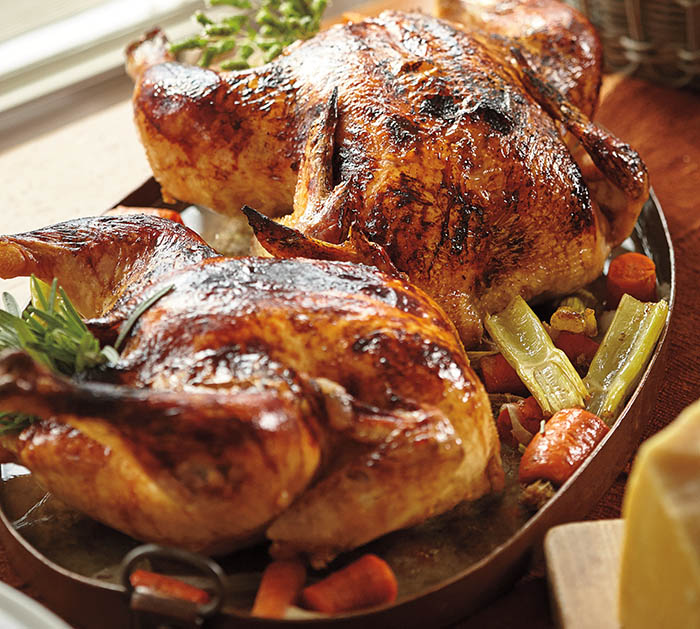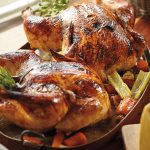Faraona Arrosto al Balsamico

The blend of balsamic vinegar and honey to baste the guinea hen gives the bird a beautiful mahogany glaze and a delicious sweet-tart taste. This glazing technique can be used for most birds; if you can’t find guinea hens, use two small organic chickens instead.
This dish makes for a festive presentation, perfect for a special dinner. Set the two birds on a cutting board or plate, decorate with some rosemary sprigs, and present them to the table; then take them back to the kitchen, carve, and serve on two platters, family style.
— Lidia Matticchio Bastianich and Tanya Bastianich Manuali
• ON-DEMAND: Listen to Faith and Lidia talk about this recipe during Lidia’s guest appearance on The Faith Middleton Food Schmooze®. •
Want more Lidia? Listen to Faith’s conversation with Lidia about her new memoir, My American Dream.
 Excerpted from Lidia’s Celebrate Like an Italian: 220 Foolproof Recipes That Make Every Meal a Party by Lidia Matticchio Bastianich and Tanya Bastianich Manuali. Published by Alfred A. Knopf, a division of Penguin Random House, LLC. Copyright © 2017 Tutti a Tavola, LLC. Photo by Steve Giralt.
Excerpted from Lidia’s Celebrate Like an Italian: 220 Foolproof Recipes That Make Every Meal a Party by Lidia Matticchio Bastianich and Tanya Bastianich Manuali. Published by Alfred A. Knopf, a division of Penguin Random House, LLC. Copyright © 2017 Tutti a Tavola, LLC. Photo by Steve Giralt.
- Two 2-1/2 pound guinea hens
- 2 teaspoons kosher salt
- freshly ground black pepper
- 4 sprigs fresh rosemary
- 4 sprigs fresh sage
- 1/4 cup extra virgin olive oil
- 2 medium onions coarsely chopped
- 1 cup chopped celery
- 1 cup chopped carrot
- 2 fresh bay leaves
- 2 cups chicken stock (homemade or storebought)
- 3 tablespoons balsamic vinegar
- 1 tablespoon honey
- Preheat oven to 425 degrees. Remove all visible fat and the neck and giblets from the hens. Rinse the hens under cold water, and pat them dry with paper towels. Season the birds generously with the salt and pepper, inside and out. Stick one rosemary sprig and one sage sprig in the cavity of each bird.
- In a heavy roasting pan or very large ovenproof skillet, heat the oil over medium heat. Add the onions, celery, carrot, the remaining rosemary and sage, and the bay leaves, and cook, stirring, until the onions are wilted, about 6 minutes. Smooth the vegetables into an even layer, and nestle the prepared hens, breast side up, over them. Roast, basting with enough of the chicken stock to keep the vegetables well moistened, until the vegetables and hens are golden brown, about 1 hour. The leg joint should wiggle somewhat freely.
- Spoon off enough of the roasting juices to measure 1 cup, not including fat. Stir in the balsamic vinegar and honey until the honey is dissolved. Baste the hens. Return the hens to the oven, and roast, continuing to baste occasionally with the honey mixture, until the hens are a rich mahogany color and the leg joint moves easily when you wiggle it, about 25 minutes. (If you are using a meat thermometer, it should register 165 degrees when inserted into the thickest part of the thigh, away from the bone.)
- Remove the hens from the oven, and cover them with a tent of aluminum foil to keep them warm. Strain the vegetables and pan juices through a sieve into a small saucepan, pressing as much of the vegetable solids through the sieve as possible. Skim the fat from the surface of the sauce, and bring the sauce to a simmer while carving.
- To carve the birds: Remove the wings by cutting through the joint that attaches them to the body. With a long, thin knife, carve out the breast meat from each side and cut thin slices of the breast meat, including some of the skin with each slice. Arrange the breast slices on a platter. Separate the legs from the body by cutting around the joint that connects the leg to the backbone. This will be easier if you first hold the leg by the tip of the drumstick and pull it away from the body, allowing you to see the joint that connects the leg to the backbone. Cut the legs in half at the knee joint. Arrange the leg pieces on the platter. Spoon some of the sauce over the bird, and pass the remaining sauce separately.
Get Lidia's tips for making homemade chicken stock.


